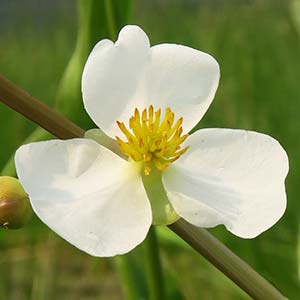Sagittaria graminea
Sagittaria latifolia
grass-leaf arrowhead, grassy arrowhead, sagittaire a feuilles de graminees
bird's-eye pearlwort, broad-leaf arrowhead, common arrowhead, duck-potato, Indian potato, sagittaire latifoliee, wapato
submersed or emersed; submersed leaves phyllodial, angled abaxially, flattened adaxially, 6.4–35 × 0.5–4 cm; emersed with petiole triangular, 6.5–17 cm, blade linear to linear-oblanceolate, 2.5–17.4 × 0.2–4 cm.
emersed;
petiole triangular, erect to ascending, 6.5–51 cm;
blade sagittate, rarely hastate, 1.5–30.5 × 2–17 cm, basal lobes equal to or less than remainder of blade.
racemes or panicles, of 1–12 whorls, emersed, 2.5–21 × 1–8 cm;
peduncles 6.5–29.7 cm;
bracts connate more than to equal to ¼ total length, broadly subulate to lanceolate, 20–50 mm, coarse, not papillose; fruiting pedicels spreading, cylindric, 0.5–5 cm.
racemes, rarely panicles, of 3–9 whorls, emersed, 4.5–28.5 × 4–23 cm;
peduncles 10–59 cm;
bracts connate more than or equal to ¼ total length, elliptic to lanceolate, 3–8 mm, delicate, not papillose; fruiting pedicels spreading, cylindric, 0.5–3.5 cm.
to 2.3 cm diam.;
sepals recurved to spreading, not enclosing flower;
filaments dilated, shorter than anthers, pubescent;
pistillate flowers pedicellate, without ring of sterile stamens.
to 4 cm diam.;
sepals recurved to spreading, not enclosing flower or fruiting head;
filaments cylindric, longer than anthers, glabrous;
pistillate pedicellate, without ring of sterile stamens.
heads 0.6–1.5 cm diam.;
achenes oblanceoloid, without abaxial keel, 1.5–2.8 × 1.1–1.5 mm, beaked;
faces not tuberculate, abaxial wings 0–1, ± entire, glands 1–2;
beak lateral, erect, 0.2 mm.
heads 1–1.7 cm diam;
achenes oblanceoloid, without abaxial keel, 2.5–3.5 × to 2 mm, beaked;
faces not tuberculate, wings absent, glands (0–)1(–2);
beak lateral, horizontal, 1–2 mm.
= 22.
Sagittaria graminea
Sagittaria latifolia
Seven varieties of Sagittaria graminea have been recognized, i.e., var. graminea, var. platyphylla Engelmann, var. teres (S. Watson) Bogin, var. weatherbiana Fernald, var. cristata (Engelmann) Bogin, var. chapmanii J. G. Smith, and var. macrocarpa (J. G. Smith) Bogin (C. Bogin 1955). We accept only one infraspecific rank, i.e., subspecies. Consequently, we have made the appropriate combinations. We accept all of the taxa accepted by Bogin at the varietal level. At specific level we accept Bogin’s var. platyphylla, var. teres, and var. cristata and at subspecific level his var. graminea, var. chapmanii, and var. weatherbiana.
Sagittaria graminea var. macrocarpa actually is synonymous with var. graminea (E. O. Beal 1960b). We therefore are following Beal in recognizing var. macrocarpa sensu Bogin as S. fasciculata. We also accept var. platyphylla, var. teres, and var. cristata at the specific level, leaving only three subspecies. These subspecies can be separated by the branching of the inflorescence and the length of pistillate pedicels.
Subspecies 3 (3 in the flora).
(Discussion copyrighted by Flora of North America; reprinted with permission.)
Sagittaria latifolia has been divided into numerous species and varieties. It was divided into two varieties, based upon the presence of pubescence over the entire vegetative plant (C. Bogin 1955; K. Rataj 1972). We have examined numerous specimens and found that many from the southeastern United States are pubescent; we believe that this character alone is insufficient for recognition of the varieties.
(Discussion copyrighted by Flora of North America; reprinted with permission.)
1. Inflorescences panicles. | subsp. chapmanii |
1. Inflorescences racemes. | → 2 |
2. Pistillate pedicels 0.5–3 cm; phyllodia less than 1 cm wide | subsp. graminea |
2. Pistillate pedicels 2.1–5 cm; phyllodia more than 1 cm wide | subsp. weatherbiana |
- Local floras:
OR,
WA
- Local Web sites:
Flora NW,
Go Botany,
IL Wildflowers,
KS Wildflowers,
LA Plants,
MD Biodiversity,
MI Flora,
MN Wildflowers,
MO Plants,
PNW Herbaria
WildflowerSearch
iNaturalist (observations)
USDA Plants Database
- LBJ Wildflower Center
- SEINet
- Plants of the World Online
- Encyclopedia of Life
- Wikipedia
- Google Image Search
- Local floras:
BC,
CA,
OR,
WA
- Local Web sites:
CalFlora,
CalPhotos,
Flora NW,
Go Botany,
IL Wildflowers,
KS Wildflowers,
LA Plants,
MD Biodiversity,
MI Flora,
MN Wildflowers,
MO Plants,
PNW Herbaria,
Turner Photog.
WildflowerSearch
iNaturalist (observations)
USDA Plants Database
- LBJ Wildflower Center
- SEINet
- Plants of the World Online
- Encyclopedia of Life
- Wikipedia
- Google Image Search
